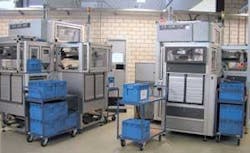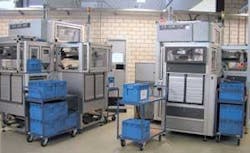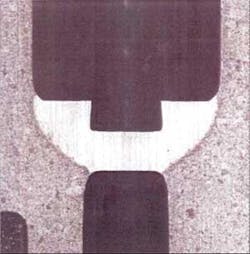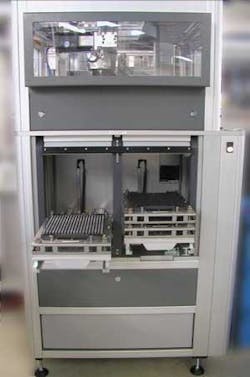Producing automotive parts
Diode lasers are deployed in serial production to harden parts for the automotive industry
Sonja Müller
SITEC Industrietechnologie (Chemnitz, Germany; ec-chemnitz.de), founded in 1991, is a manufacturer of laser processing systems that has, since 2003, also been hardening parts as a large-volume supplier to the automotive industry. Every week approximately 60,000 precision ready parts are manufactured per system (see Figure 1) in 15 shifts.
null
Benefits of laser hardening
The customer’s process requirements are high: a wall in an almost inaccessible location, in a precision, rotation symmetric component, has to be hardened (see Figure 2). “The reason for using the laser is that these components have to be precisely the same size after hardening, as there is no possibility for reprocessing. Due to highly precise local and periodic heat monitoring we can work on finished parts here,” says Dr. Klaus-Peter Wolf, who is responsible for the company’s laser lines.
Laser hardening systems are almost always customized solutions, so extensive prior trials were necessary to determine the optimum process parameters. After these trials, using a Nd:YAG laser, it was determined that the use of a diode laser made sense from a technical and economical perspective. Significantly lower investment costs, moderate operating costs, and a wavelength that was perfectly suited to surface processing were the winning arguments. SITEC uses a Rofin-Sinar Laser GmbH (Hamburg, Germany) 1.0kW diode laser, which is completely integrated into a newly developed system thanks to its highly compact dimensions.
Hardening without oxidization
A pallet system (see Figure 3) supplies the existing parts, which are made from special tempering steel, and allows loading and unloading without interrupting the process. The parts are conveyed from the pallets via a circular switch table into a nitrogen atmosphere and processed in a six-second cycle. Dr. Wolf says, “By setting up this nitrogen atmosphere we have managed hardening of the components without oxidization. As a result the exterior of the finished parts cannot be differentiated from that of unhardened parts.” In order to achieve homogenous hardening of the rotational symmetric parts with the diode laser’s square beam without using a cylindrical lens, the parts are rotated at 3000 rotations per minute during the process.
null
Competent development partners
The development of this system was carried out in a joint project with SITEC and the Institut für Werkzeug und Strahltechnik (IWS-Dresden) who developed temperature-regulated laser performance controls (lasertronic LompocPro) with which quality assurance can be completely accomplished. During the hardening process the hardening temperature and heating speed are recorded by an online checking mechanism.
These values are processed by a power control, so that the temperature on the surface of the part can be held constant by regulation of the laser beam. Deviations from the reference ranges indicate errors in the parts, such as shavings from the previous processes or incorrect temperature. These values are recorded and consequently the part is separated out as non-compliant. In addition to this online check of the procedure, every thousandth part is separated out and checked metallographically.
Make three from two
The high customer requirements in terms of quality and availability of the parts meant that a second diode laser was set up from the start of the project as a backup solution. During production however a machine availability level of 95 percent was achieved, according to Dr. Wolf. This meant that, with an increased customer demand, a second system could be set up last year using this backup laser. Due to this increase in capacity up to 6,000,000 parts can now be hardened per year.
Dipl.-Wirtschaftsing Sonja Müller, Rofin-Sinar Laser GmbH (Hamburg, Germany; www.rofin.com) can be reached by e-mail at [email protected].
About SITEC
SITEC, which today employs 140 people, was founded in 1991 by Dr. Harald Förster and Dr. Klaus Rudolph-former employees of the Forschungszentrum für Werkzeugmaschinenbau (Tooling Machinery Research Centre) in Chemnitz, Germany. The company rapidly expanded from an engineering service provider to a profitable manufacturing company. Today the offering ranges from planning, project management, and the development of customized assembly systems combined with innovative technologies, modular laser systems, and ECM systems and ECM fittings to services such as laser toll manufacture. It counts companies such as Volkswagen, Opel, BMW, Carl Zeiss Jena, Siemens VDO, and many others as customers.
Diode lasers
For high-performance diode lasers many single radiating semiconductor lasers are optically combined. A laser bar, containing between 20 and 25 individual strips, typically demonstrates dimensions of approximately 10mm x 0.6mm x 0.1 mm. This bar is fitted for cooling on one of the cooling bodies through which water circulates. The power used today industrially generated by such a bar is about 50 watts. By properly stacking these bars the laser power of the individual bars cumulates due to the optical overlapping of the individual beam bundles. Thus, if several stacks are combined, several thousand watts of power can be generated in the wavelength range of 790 to 980 nm.
However, the combination of many individual beams impacts the quality of the beam and the focusing capabilities. This means that a lower power intensity of the surface of the workpiece can be reached in comparison to the conventional laser types. This currently restricts the areas of application for high-performance diode lasers. However, there are a host of benefits: diode lasers are extremely compact, they are easy to integrate into existing systems, they demonstrate a typical diode life span of more than 10,000 hours, and they have a high effectiveness level of up to 25 percent.



